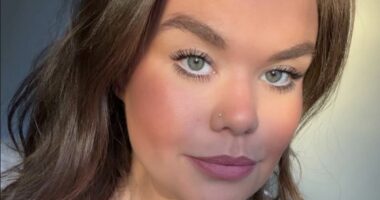Share this @internewscast.com
Does your vacation rental smell musty, or are the sheets slightly stained? We’re sorry to say, but there might be bedbugs lurking around you.
One way these tiny insects can spread is through rented rooms – like short-term rentals, hotel rooms and more – where they hitchhike to their next destination via guests’ clothing and luggage.
While the reddish-brown, wingless insects cannot carry illnesses, their bites can cause bright red hives and blisters on the skin.
Even though bites are the most commonly known marker, the lesions are actually a poor indicator of an infestation as they can also look like bites from other insects including mosquitoes, or rashes caused by eczema or fungal infections.
Thankfully, certain telltale signs can alert you to their presence well before you come into contact with these little stowaways.
Stains on the sheets or mattress
Red bloodstains on any part of the bedding or in the corners of the mattress are a clear sign of bedbug trouble.
When the bugs get squashed between bedding, they release a lot of blood.
These spots are mostly seen around the seams of mattresses, which is where they tend to hide, and between layers of bedding such as the duvet and flat sheet.
Reddish-black waste stains may also be a sign of infestation.
According to the Virginia Department of Agriculture, the insects feed every five to seven days if a host is present. When there isn’t a host to feed on, they spend their time digesting their previous meal.

One way bedbugs can spread is through rented rooms, where they hitchhike lifts in guests’ clothing and luggage
Since human blood is made up of 80 percent water, bedbugs end up excreting some of the excess liquid as waste in a semiliquid form.
This waste can be easily seen on the surfaces of mattresses, bed frames and other locations where the bed bugs travel or aggregate.
Fecal spots can be found anywhere in a large infestation, but when the infestation is small, there are some places the fecal spots are more likely to be found, such as along the mattress seams and on the tag.
To look for signs, Dr. Jim Fredericks, a board-certified entomologist, suggests travelers ‘Pull back the sheets and inspect the mattress seams and box springs, particularly at the corners, for pepper-like stains or spots.’
Large mattress stains in any color other than red – such as yellow or blue – may not be a sign of bedbugs.
Leftover skin casings
Even if you don’t see an insect scurrying to hide, leftover skin casings or shreds of a bedbug’s exoskeleton may indicate a severe infestation.
Bedbugs shed their skin in order to grow to the next life stage, molting five times before they reach adulthood.
In an established, large infestation, there will be many thousands of these abandoned skins lying around.
On the other hand, in a new, smaller infestation, bed bug evidence may be very hard to find at first.
However, it is safe to assume that a certain percentage of any bed bug population is always in an immature stage – there is always potential to find these dead skins, which are the same shape as the insect itself and generally translucent in color.

Pictured: Dr. Jim Fredericks, a board-certified entomologist

Bedbugs shed their skin in order to grow to the next life stage. They molt five times before reaching adulthood
A stale smell
A strong, damp odor or a musty, stale smell in a room may suggest it’s filled with bed bugs.
The specific smell that people detect can vary, with some describing it as akin to the scent of coriander, wet towels, moldy shoes or spoiled berries.
Bedbugs are known to release pheromones – chemical signals used for communication within a species – when disturbed, which can create an unpleasant odor. This is especially true for large infestations.
At times, dried up bedbug waste can also contribute to the musty or sour odor.
However, this smell can also come from mold. So, while it may be a hint at unwanted extra room guests, it is best to check for other signs before you call the hotel’s reception.

A strong, damp odor or a musty, stale smell may suggest a room is filled with bedbugs
Tiny white eggs
Sometimes, you may not spot a bedbug itself, but you may see a tiny, white egg or eggshells.
Bedbug eggs are merely one to four millimeters in size and resemble small grains of rice.
They are often found clustered in small, tight spaces like mattress seams, crevices in the bed frame or within the folds of sheets
According to Dr. Fredericks, visitors should ‘thoroughly inspect the entire room before unpacking including behind the headboard, under lights, inside dressers, drawers, sofas and chairs’ to check for eggs.
















